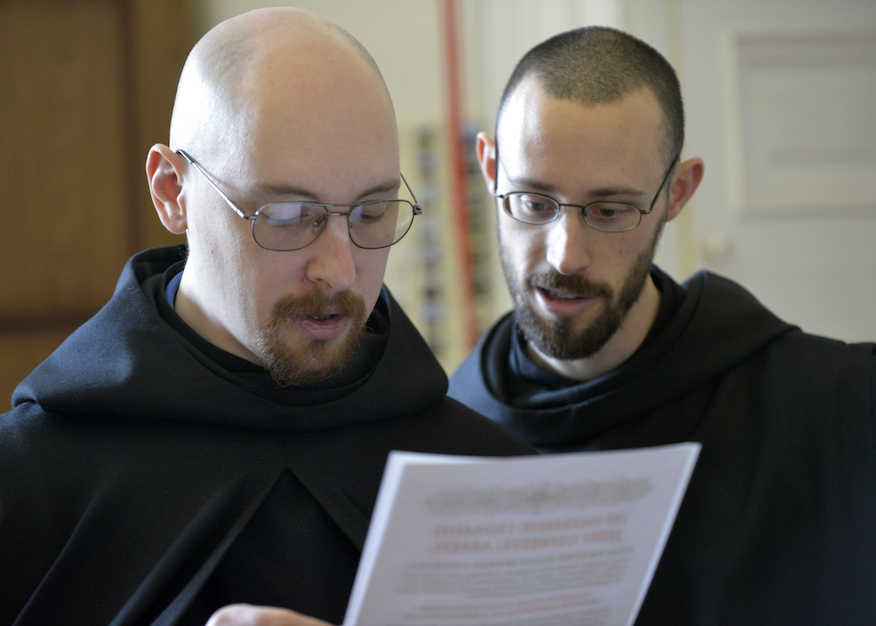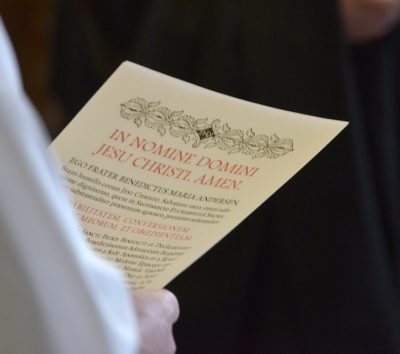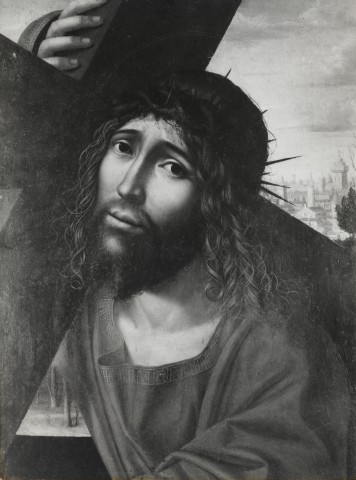Of the Discipline of Receiving Brethren into Religion (LVIII:2))

12 Apr. 12 Aug. 12 Dec.
Let him who is to be received make before all, in the Oratory, a promise of stability, conversion of manners, and obedience, in the presence of God and of His saints, so that, if he should ever act otherwise, he may know that he will be condemned by Him Whom he mocketh. Let him draw up this promise in writing, in the name of the saints whose relics are in the altar, and of the Abbot there present. And let him write it with his own hand; or at least, if he knoweth not how, let another write it at his request, and let the Novice put his mark to it, and place it with his own hand upon the altar. When he hath done this, let the Novice himself immediately begin this verse: “Take Thou me unto Thyself, O Lord, according to Thy Word, and let me not be let down in my expectation.” And this verse let the whole community thrice repeat, adding thereto Gloria Patri. Then let the newly-received brother cast himself at the feet of all, that they may pray for him, and from that day let him be counted as one of the community. Whatever property he hath let him first bestow upon the poor, or by a solemn deed of gift make over to the Monastery, keeping nothing of it all for himself, as knowing that from that day forward he will have no power even over his own body. Forthwith, therefore, in the Oratory, let him be stripped of his own garments, wherewith he is clad, and be clothed in those of the Monastery. And let the garments that are taken from him be laid by and kept in the wardrobe; so that if ever, by the persuasion of the devil, he consent (which God forbid) to leave the Monastery, he may be stripped of the monastic habit and cast forth. But the form of his profession, which the Abbot took from the altar, shall not be given back to him, but be kept in the Monastery.
Nowhere is the Eucharistic subtext of the Rule of Saint Benedict more apparent than in Chapters LVIII and LVIX. The entire rite of monastic profession is presented as an oblation or, if you will, as a sacrificial immolation. The monk is a victim (hostia) offering himself to the Father, through Christ, the Eternal High Priest. Saint Benedict sets the rite of monastic profession in the oratory of the monastery, that is, before the altar, the place of the Holy Sacrifice. There, with the Church on earth and in heaven as witness, he promises stability, conversion of his life, and obedience.
Why then, since we are watched from above by such a cloud of witnesses, let us rid ourselves of all that weighs us down, of the sinful habit that clings so closely, and run, with all endurance, the race for which we are entered. (Hebrews 12:1)
The saints in heaven, represented on earth by the holy relics venerated in the altar of the monastery church, look on as the new monk lays his very life upon the altar. The saints intercede for the remission of his sins, that he may walk — no, run with all endurance — henceforth in newness of life, until at length he  reaches the heavenly Jerusalem where they will welcome him into the choirs of the blessed.
reaches the heavenly Jerusalem where they will welcome him into the choirs of the blessed.
The act of profession is written out by the hand of the monk himself. In many monasteries the making of the chart of profession has become an act of love: the text is a thing of beauty, written in calligraphy, often with illuminations and considerable artistry. Saint Benedict orders that the monk himself place the chart of profession, with his own hand, upon the altar. Like the bread and wine made over to God at the Offertory of the Mass, in view of the consecration, the newly-professed monk is an oblation made ready for consecration and immolation. The ritual of profession and, effectively, the whole life of the monk is Eucharistic and sacrificial. It is a mystic identification with Christ, Priest and Victim (the Offerer and the Offering), ratified by the Church. Monastic profession is an act of λατρεία. By it, the monk is, as Dante says so beautifully, disposto a sola latria, disposed to nothing apart from the adoration of God (Dante Alighieri, Divina Commedia, Canto XXI del Paradiso, v. 106-111). Saint Augustine says:
To Him we owe the service which is called in Greek λατρεία, whether we render it outwardly or inwardly; for we are all His temple, each of us severally and all of us together, because He condescends to inhabit each individually and the whole harmonious body, being no greater in all than in each, since He is neither expanded nor divided. Our heart when it rises to Him is His altar; the priest who intercedes for us is His Only-begotten; we sacrifice to Him bleeding victims when we contend for His truth even unto blood; to Him we offer the sweetest incense when we come before Him burning with holy and pious love; to Him we devote and surrender ourselves and His gifts in us; to Him, by solemn feasts and on appointed days, we consecrate the memory of His benefits, lest through the lapse of time ungrateful oblivion should steal upon us; to Him we offer on the altar of our heart the sacrifice of humility and praise, kindled by the fire of burning love. It is that we may see Him, so far as He can be seen; it is that we may cleave to Him, that we are cleansed from all stain of sins and evil passions, and are consecrated in His name. For He is the fountain of our happiness, He the end of all our desires. Being attached to Him, or rather let me say, re-attached,— for we had detached ourselves and lost hold of Him—being, I say, re-attached to Him, we tend towards Him by love, that we may rest in Him, and find our blessedness by attaining that end. (City of God, Book X, Chapter 3)
Saint Benedict directs that, after the chart has placed upon the altar, the novice himself is to intone this verse: Suscipe me, Domine, secundum eloquium tuum, et vivam: et ne confundas me ab expectatione mea, “Take Thou me unto Thyself, O Lord, and I shall live; and let me not be let down in my expectation” (Psalm 118:116). Whenever Saint Benedict wants to emphasize a particular verse, he orders its threefold repetition. In this instance, not only does the newly-professed monk sing the verse three times; it is also repeated three times by the whole community, and crowned with the singing of the Gloria Patri. This confers upon the singing of the Suscipe a character of solemnity and grandeur. It signifies the moment in which the Father lays claim to the self-offering of the new monk, in whom He recognizes the pattern of His own Beloved Son’s immolation from the altar of the Cross. Saint Augustine says that whatsoever is placed upon the altar becomes sacrificium, a true sacrifice, that is, a thing irrevocably made over to God alone.
Though made or offered by man, is a divine thing, as those who called it a sacrifice meant to indicate. Thus man himself, consecrated in the name of God, and vowed to God, is a sacrifice in so far as he dies to the world that he may live to God. (City of God, Book X, Chapter 6)
Saint Augustine’s exposition of the meaning of sacrifice is fundamentally related to Our Lord’s use of the word ἁγιάζω in the Priestly Prayer of the Fourth Gospel. When Our Lord says,”and for them do I sanctify (or consecrate) myself, that they also may be sanctified (or consecrated) in truth” (John 17:19), He is, in effect, saying, “and for them do I make myself a sacrificial victim, that they also may be made sacrificial victims in truth”. The chart of profession, signed by the monk and placed upon the altar, represents the monk’s identification with the bread and wine that there become the adorable Body and precious Blood of the “the Lamb slain in sacrifice ever since the world was made” (Apocalypse 13:8).
This understanding of the victimal and sacrificial character of monastic profession has, alas, waned in recent years, in part because the presentation and understanding of the Mass itself as Our Lord’s Holy Sacrifice to the Father, renewed in an unbloody manner, has suffered an eclipse in the minds of the clergy and faithful alike. This can be attributed, I think, in no small measure, to the widespread (and almost universal) loss of the practice of priest and people facing together in a single Godward direction at the moment of offering the Holy Sacrifice. The restoration of the position versus Deum for the Offertory and Canon of the Mass is the single most effective tool in presenting a renewed catechesis of the Holy Sacrifice of the Mass and of a sacrificing priesthood. The Suscipe of the newly-professed monk finds a further echo in the Offertory prayers of the Mass:
Suscipe, Sancte Pater . . . Take unto Thyself, Holy Father, almighty and everlasting God this unblemished sacrificial offering, which I Thy unworthy servant, make to Thee, my living and true God, for my countless sins, offences, and neglects, and on behalf of all who are present here; likewise for all believing Christians, living and dead. Accept it for their good and mine, so that it may save us, and bring us to everlasting life. Amen.
Again, the prayer after the offering of chalice, might well be said by the monk offering himself:
In spiritu humilitatis . . . Humbled in spirit and contrite of heart, may we find favour with Thee, O Lord, and may our sacrifice be so offered in Thy sight this day that it may please Thee, Lord God.
The word Suscipe occurs again in the prayer that concludes the Offertory rite:
Take Thou unto Thyself, O Holy Trinity, the offering we here make to Thee in memory of the passion, resurrection, and ascension of Our Lord Jesus Christ; in honour, too, of blessed Mary, ever-virgin, of blessed John the Baptist, of the holy apostles Peter and Paul, of these, and of all the saints. To them let it bring honour, to us salvation, and may they whom we are commemorating on earth deign to plead for us in heaven: through the same Christ our Lord. Amen.
Finally, Saint Benedict, directs the newly-professed and offered monk to prostrate himself before the feet of each monk in the community, asking them to pray for him. While, in many monastic communities this rite has become a gesture of welcome and of congratulations, such is not the mind of our holy legislator. Saint Benedict has the new monk kneel at the feet of his fathers in Christ to beg their prayers. The rite has a certain analogy with the Orate, Fratres of the Mass:
Pray brethren, that my sacrifice and yours may find acceptance with God the almighty Father. R. May the Lord accept the sacrifice at your hands, to the praise and glory of His Name, for our welfare also, and that of all His holy Church.
Following this, in the traditional rite of monastic profession and consecration, the monk prostrates himself before the altar for the entire duration of the Holy Mysteries. Dom Delatte, the great teaching abbot of Solesmes, offers a mystagogical exposition of the rite:
There lies there a living man, a man renewed; there is a living victim, “a pure, holy, and unspotted victim,” reunited to the victim on the altar, offered and accepted with that same victim, and enwrapped by the deacon in the fragrance of the same incense.Then the Mass continues. Motionless and silent like the Lamb of God, the newly professed suffers himself to be immolated and consumed mystically by the Eternal High Priest. How sweet that Mass and that Communion. Our whole monastic life should resemble this profession Mass. (Commentary on the Rule of Saint Benedict, translated by Abbot Justin McCann, O.S.B., p. 401–402)

